'Art All' Arte 9 - The Shape of the Clouds' Co-curated with Achille Bonito Oliva The two invited curators for the annual event of Arte all’ Arte collaborate to choose six artists to create new works for the six designated Tuscan towns in the Siena area. Since I worked most closely with, Tadashi Kawamata, Lucy Orta and Antony Gormley I shall concentrate on describing their projects. Tadashi Kawamata chose the site of Porta Nuova at Colle di Val d’Elsa, the former medieval gateway to the town undergoing restoration. He decided to regard this temporary building site as an integral part of his installation of a new work. It is possible to see exactly where the original, now lost wooden gate was located in the architecture and Kawamata decided to create a new door, his own Porta Nuova.. In arriving at a design concept he had an inspiring dialogue with the teacher and children of the nearby school through their project to study and draw the town’s ancient doors. He acknowledged this influence by including an exhibition of their drawings as part of his project and he also conducted a workshop with them. While the original function of the door was to protect its citizens from attack and exclude ‘outsiders’, through the lightness and transparency of it’s design, Kawamata’s Porta Nuova expresses the idea of temporality and open access. Lucy Orta’s project for Buonconvento had two separate but related elements, an exterior installation involving hanging textile forms and a series of works placed within the town’s Museum. Connector Body Architecture with its gaily-coloured red, yellow and silver-white hooded garments hanging against the modest brickwork of the gateway assumed a role of ‘neo-heraldry’. Inspired by the Tuscan tradition of suspending brightly coloured flags and banners from their architecture, Orta used these works to signify the verticality of the gates and towers. For the other part of her project, she installed a series of specially made sculptures in glass and steel in a gallery of Buonconvento’s Sacred Art Museum. They were created through collaboration with local artisans and celebrate Colle di Val d’Elsa’s glass blowing tradition. Totipotent Architecture, consisted of cut metal architectural silhouettes of Tuscan buildings with 'organic' blown glass extensions installed along the length of the gallery. They included an interactive part where the local people could write down their secret wishes for the future, insert them in glass test-tubes which they then deposited at the base of the sculpture. The town of Poggibonsi was Antony Gormley’s chosen site for his ambitious project Making Space, Taking Place. In contrast to the charming, picturesque character of the other participating towns, Poggibonsi had an element of anonymity that appealed to himThe project involved the production of seven iron sculptures produced from body-casts of Poggibonsi citizens and one passer-by. Advertisements were placed in local and national newspapers in order to recruit volunteers to have plaster moulds taken of their bodies and then cast in iron. A public lottery was then staged to choose the participants from those that responded. A temporary workshop was set up in the town to produce the moulds, which were subsequently shipped to the UK to be prepared in the artist’s studio. Rectangular polystyrene blocks were cut, glued and fitted to the contours of the moulds then cast in an industrial facility in Sheffield using the ‘lost polystyrene process’. After finishing, the seven iron sculptures of pixselised-form were then transported back to Poggibonsi for installation at seven sites within the town. These were both familiar places of the present and forgotten places of the past and ranged from town square, pavement, park, supermarket and railway platform. Parallel to the sculpture production, a unique sociological survey was conducted from which a collective memory map of Poggibonshe was created. A list of questions was put to the citizens asking them about the kinds of memories they most readily associated with certain sites in the town. The map and completed questionnaires was displayed at a local visitor centre along with archive photos of the town and its people together with documentation of making the sculptures. Assoc. Arte Continua, www.artecontinua.org
|
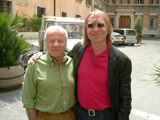 |
||
| Achile Bonito Oliva and James Putnam |
|||
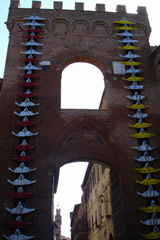 |
|||
| Lucy Orta |
|||
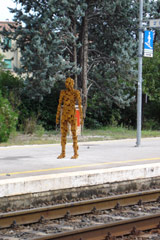 |
|||
Antony Gormley |
|||
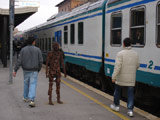 |
|||
Antony Gormley |
|||
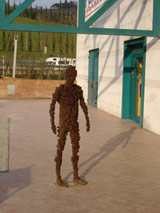 Antony Gormley |
|||